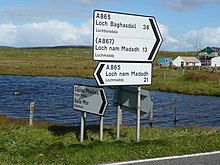Unival
The Cairn of Unival is a polygonal passage tomb located on a hill not far from the town of Bayhead in the west of the Hebridean island of North Uist in Scotland (site number NF86NW 4). The megalithic complex was probably built in the Neolithic Age in the 4th millennium BC. And was used from the Bronze Age to the Iron Age . Ceramics from all these periods have been found during archaeological excavations .
Excavations
The Orkney-Cromarty-Type (OC) passage tomb was excavated by W. Lindsay Scott in 1935 and 1939. The excavation report did not appear until 1950, apart from smaller reports about the pottery found, because of the war years from 1939 to 1945.
description
The complex has an irregular, almost square stone mound with a side length of about 16 meters. The polygonal chamber can be entered through a 1.4 meter long corridor from the southeast side. Ten of the hill's unusually high curbs remain. Five of them form the orthostats of a facade in which megaliths and dry masonry alternate. The floor plan of this facade, in the middle of which was the entrance to the complex, appears to be slightly curved outwards. The stone height increases towards the entrance and reaches 2.5 meters there.

During the excavation in the 1930s, numerous fragments of ceramic were found in the chamber and in the passage, which comes from the Eilean na Tighe one of the Shiant Islands ( Harris ) and has so far only been found in Unival and in the megalithic complex of Clettraval . Two stone balls (one made of pumice stone ) were found in the chamber area. The remains of a woman more than 25 years old and the ribs of a somewhat younger individual, which seem to belong to an earlier burial, were found in a stone box inside the chamber (see quarters ).
During the Iron Age, a house with two rooms was built into the northeast side of the hill. For this purpose, some of the surrounding stones were removed. Other, unexcavated houses are located in the northwest of the hill. At this time, the chamber roof had already been removed. It is believed that the chamber was misused.
About seven meters from the southwest corner of the grave is a three-meter high menhir (standing stone) that is up to 1.45 meters wide. From this stone you can see the megalithic complexes of South Clettraval and the passage tomb of Barpa Langass .
Individual evidence
- ^ A b Lindsay Scott: The Chamber Tomb of Unival, North Uist. Proceedings of the Society of Antiquaries of Scotland, 82, 1947-1948, pp. 1-49, 1950
- ↑ a b Entry on Unival in Canmore, the database of Historic Environment Scotland (English)
- ^ Richard Hingley: Ancestors and Identity in the Later Prehistory of Atlantic Scotland: The Reuse and Reinvention of Neolithic Monuments and Material Culture. World Archeology, 28, 2, pp. 239, 1996 (Sacred Geography)
literature
- Anna Ritchie, Graham Ritchie : Scotland. To Oxford Archaeological Guide . Oxford Archaeological Guides, Oxford University Press, Oxford 1998 ISBN 0-19-288002-0
- LW Scott: The chamber Tomb of Unival, North Uist In: Proceedings of the Society of Antiquaries of Scotland 82 1950 pp. 1-49
Web links
- Entry on Unival in Canmore, Historic Environment Scotland's database
- Unival , Stonpages.org, brief description and photo, accessed on May 19, 2015
- Unival , picture with menhir and photo spread by Cole Henley on flickr, accessed on 19 May 2015
Coordinates: 57 ° 34 ′ 40.7 ″ N , 7 ° 21 ′ 18 ″ W.